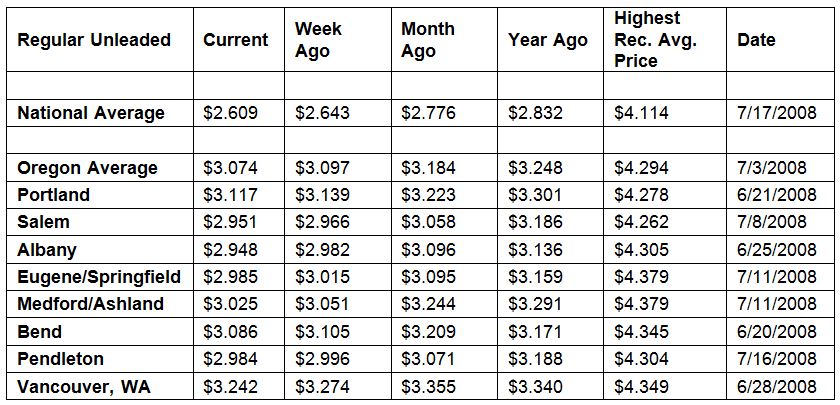PORTLAND, Ore., – Summer may be winding down but gasoline demand is soaring to new heights at nearly 10 million b/d. This jump in demand is slowing the rate at which gas prices are declining. For the week, the national average for regular falls three cents to $2.61 a gallon. The Oregon average loses two cents to $3.07.
The latest data from the U.S. Energy Information Administration (EIA) for the week ending August 9 shows that gasoline demand rose to 9.93 million b/d, the highest since the agency began recording data in 1991. As demand jumped, gasoline stocks fell by 1.4 million bbl and pump prices slowed their decline on the week.
“Pump prices continue to move lower, but all states are seeing week-over-week decreases of a nickel or less,” says Marie Dodds, public affairs director for AAA Oregon/Idaho. “Demand is expected to drop in the coming weeks as kids go back to school and the summer travel season comes to an end.”
Oregon is one of 49 states and the District of Columbia where prices are lower now than a week ago. Illinois (-5 cents) has the largest weekly drop. Arizona is the only state with a weekly increase and it is only seven-tenths of a cent. This week there are six states with an average above $3 a gallon, same as a week ago.
Oregon is one of 49 states and the District of Columbia with lower prices now than a month ago. The national average is 17 cents less and the Oregon average is 11 cents less than a month ago. This is the 36th-largest monthly decline in the nation. Illinois (-32 cents) has the largest month-over-month decline. Utah (+1 cent) is the only state with a monthly increase.
Drivers in all 50 states and the District of Columbia are paying less than a year ago. The national average is 22 cents less and the Oregon average is 17 cents less than a year ago. Idaho (-40 cents) has the largest year-over-year drop.
The West Coast continues to have the highest pump prices in the nation with all of the region’s states except Arizona landing on the top 10 most expensive list.
| Rank | Region | Price on 8/20/19 | |
| 1 | Hawaii | $3.65 | |
| 2 | California | $3.59 | |
| 3 | Washington | $3.23 | |
| 4 | Nevada | $3.16 | |
| 5 | Oregon | $3.07 | |
| 6 | Alaska | $3.04 | |
| 7 | Utah | $2.89 | |
| 8 | Idaho | $2.84 | |
| 9 | New York | $2.81 | |
| 10 | Connecticut | $2.80 |
Hawaii is most expensive for the second week in a row with California, Washington, Nevada, Oregon and Alaska rounding out the top six. Oregon is fifth most expensive for the fifth week in a row.
Most state averages in the region have decreased on the week, with Alaska (-4 cents) seeing the largest decline.
The EIA’s recent report for the week ending on August 9 showed that West Coast gasoline stocks sit at 30.2 million bbl, falling by 1.5 million bbl from the previous week. The current level is approximately 100,000 bbl lower than last year at this time, which could cause prices to increase moderately if there is any disruption in supply or an increase in gas demand in the region this week.
The cheapest gas in the nation can be found in Louisiana ($2.23) and Mississippi ($2.24). For the 27th week in a row, no states have an average below $2 a gallon.
Oil market dynamics
Crude prices rose at the end of last week after sustaining heavy losses for two days. The losses came as a result of continued market worries about crude demand slumping this fall as a result of the ongoing trade dispute between the United States and China, the world’s two largest oil consuming countries. If the trade dispute continues this week, crude prices may see further declines.
Additionally, last week OPEC trimmed its global oil demand forecast, citing a slowing economy. OPEC now calculates that this year’s crude demand growth will hit 1.1 million b/d on a year-over-year basis. The new rate reflects a slight dip of 40,000 b/d due to a slowdown in global demand trends in the first half of 2019.
At the close of Friday’s formal trading session on the NYMEX, WTI increased by 40 cents to settle at $54.87. At the close of Monday’s formal trading session on the NYMEX, WTI added $1.34 to $56.21. Today crude is trading around $56, compared to $57 a week ago. Crude prices are down about one percent in the last month and are about $10 per barrel less than a year ago.
Drivers can find current gas prices along their route with the free AAA Mobile app for iPhone, iPad and Android. The app can also be used to map a route, find discounts, book a hotel and access AAA roadside assistance. Learn more at AAA.com/mobile.
Diesel
For the week, the national average slips a penny to $2.95 a gallon. Oregon’s average loses two cents to $3.14. A year ago the national average for diesel was $3.14 and the Oregon average was $3.39.
Find current fuel prices at GasPrices.AAA.com.
AAA news releases, high resolution images, broadcast-quality video, fact sheets and podcasts are available on the AAA NewsRoom at NewsRoom.AAA.com.
Find local news releases at https://www.oregon.aaa.com/category/news-releases/



